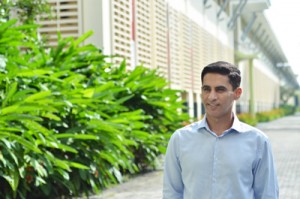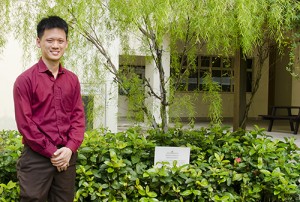Why Singapore’s English Teachers Should Embrace Singlish, Not Fight It
Is it time for Singaporean educators to embrace Singlish as a legitimate learning tool? What the Research […]
Read More
Problems are not all bad, and can even help you learn better! Students who have to generate problems before they learn a Math concept showed significantly better knowledge transfer than those who delved straight into solving a problem given to them.

Associate Professor Manu Kapur conceptualized the notion of Productive Failure (PF), and explains it as a “design for failure experiences that help in the initial learning” of a concept.
It is the process of using failure to kick-start mechanisms that enhance the learning of a new concept, as opposed to the typical way of teaching new concepts with specific goals in mind.
“It is through the failures that a wide net of conceptions, questions, representations, ideas, and solutions are activated,” Manu describes. “Even though these points of activation are expected to be incorrect or sub-optimal, they are still beneficial for the learning of a new concept.”
“Problem finding is one mechanism which affords students the opportunity to ask a lot of questions, before they learn what it is that they are supposed to learn,” continues Manu.
When SingTeach last interviewed Manu on this (Issue 37, Jul/Aug 2012), he shared briefly about the process of problem finding and its implications for schooling and education.
He has since published a paper in the Journal of European Association for Research on Learning and Instruction (EARLI) on “The preparatory effects of problem solving versus problem posing on learning from instruction”.
His paper suggests that “problem posing is a more beneficial preparatory activity than problem solving for knowledge transfer, though problem solving is critical for the development of conceptual understanding” (Kapur, 2015, p. 30).
In problem finding, or problem posing, students are not told what it is they are going to learn about, says Manu.
“We give them a context which is designed in particular ways for them to generate questions,” he continues. “It doesn’t matter if the questions are relevant or not, and in that sense they can be failed questions.”
One example of this problem-finding process, as described in his paper, is to provide students with a set of data, without telling them the Math concepts they were going to learn. Students were then asked to generate possible questions that could be mathematically asked and answered within the context of the data.
He describes how, through generating questions or problems, “they are first generating what is meaningful to them based on their prior and intuitive knowledge”. This process helps to frame what is meaningful to them, and what gets learned later.
“It is this activation process that prepares them to learn something,” he explains.

Manu reveals that part of the reason he engages in research on problem finding is because “most of the schooling experience of children is around problems that are given to or defined for them”.
Pursuant to that, “real creativity and inventiveness do not come around,” he says.
Inventive and creative capacities may still be developed when solving problems, but they are done so within the limits of a given specific goal.
By removing this given goal from the process of problem finding, the importance of asking good questions can both be developed and leveraged to learn something new.
Manu wants to find a way to cultivate aspects of creativity and inventiveness in students, while teaching formal knowledge at the same time.
“When we design these (problem-finding) tasks, we are not just thinking of activating formal knowledge,” he says. “The activation system is designed to activate both the formal as well as the intuitive, experiential and informal ways of thinking about the world.”
Such learning goes beyond the classrooms, as students will learn to look around themselves as members of the society, and to frame situations to generate problems that are significant and require solutions.
“In the teaching of the subjects, we tend to privilege content knowledge quite a lot. But we also want to build all these other things such as inventiveness, critical thinking, creativity, imagination, and so on,” Manu adds.
There is certainly an important place in the classroom for domain knowledge and problem-solving skills. Manu’s aim is to design teaching in ways that integrates the development of domain knowledge with other equally important skills and dispositions such as team work, inventiveness, creativity, resilience, and so on.
It is through the failures that a wide net of conceptions, questions, representations, ideas, and solutions are activated. Even though these points of activation are expected to be incorrect or sub-optimal, they are still beneficial for the learning of a new concept.
– Manu Kapur, Learning Sciences Lab
So far, Manu and his research team have introduced the PF approach to 7982 students and 137 teachers in 24 Singapore schools.
One of the teachers who worked with Manu and his team is Mr Jaron Pow, who was formerly the Head of Department (Math) at Millennia Institute (MI).
Jaron, who is now a Year Head at Jurongville Secondary School, says the collaboration had given the teachers at MI “extensive exposure to consider how learning works, as opposed to how best to deliver A-Level contents”.
“It was really a great project for us because, if I could say so, this is my most successful collaboration in terms of how much it affected the teachers’ competency, in all the work that I’ve done in my 3 to 4 years as Math HOD,” he adds.
Learning about PF had an effect on the way he interacted with his students.
“For myself and another teacher, we really changed our practice on a daily basis,” Jaron explains. “Students would ask us a question during recess, and the way we approached it became very different – we are now very careful not to provide the answer. True to constructivism, we now seek first to understand what students have attempted in the problem prior to consulting us, and intentionally use their prior thinking as the starting point for our discussion with the student.”
Recognizing that the principles of PF align with recommendations made in the latest review of the A-Level Math curriculum, MOE recently awarded Manu and his team a grant to translate the PF design principles across key concepts in the A-Level Statistics curriculum.
That is good news for both the researchers and teachers, because as Jaron concludes, “I really feel that it (PF) has made a sound difference in practice.”
Reference
Kapur, M. (2015). The preparatory effects of problem solving versus problem posing on learning from instruction. Journal of European Association for Research on Learning and Instruction, 39(October 2015), 23-31.